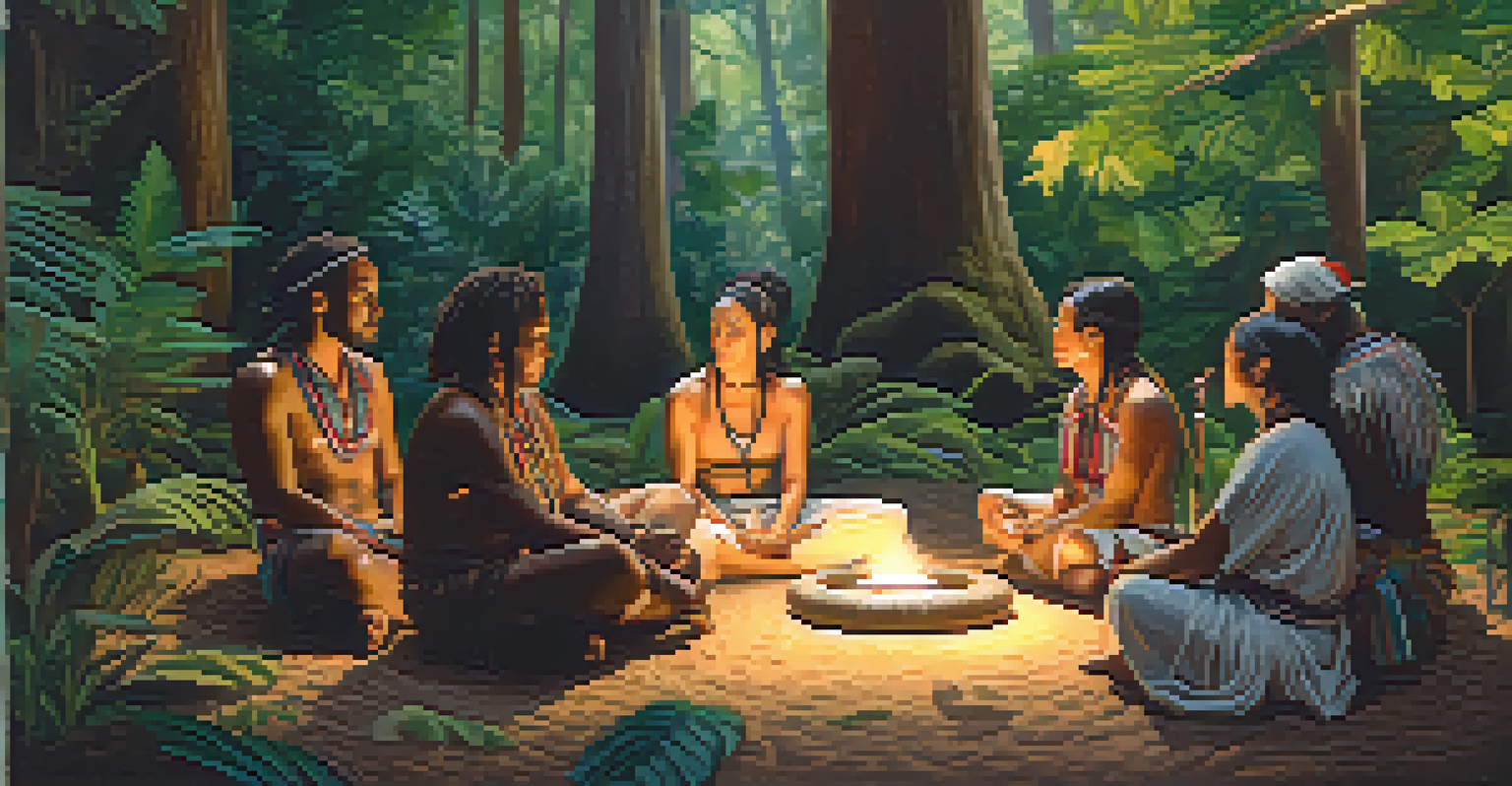Understanding the Impact of Peyote on Group Dynamics

What is Peyote? A Brief Overview
Peyote is a small, spineless cactus, scientifically known as Lophophora williamsii. It has been used for thousands of years by indigenous peoples in North America, primarily for its psychoactive properties. The main compound in peyote is mescaline, which induces altered states of consciousness and can lead to profound personal insights.
The experience of peyote is one of connection—to ourselves, to each other, and to the universe.
In many cultures, peyote is used during spiritual ceremonies and rituals, fostering a deep connection with nature and the universe. This cultural significance adds layers to its effects, especially within group settings. Understanding the context of peyote use is crucial for appreciating its impact on group dynamics.
As we delve deeper into how peyote influences group interactions, it’s important to recognize its historical and cultural background. This foundation helps us understand the potential benefits and challenges that arise when it’s used in a communal setting.
The Psychological Effects of Peyote on Individuals
The psychological effects of peyote can vary widely among individuals. Many users report feelings of euphoria, heightened sensory perception, and deep introspection. However, these experiences can also include anxiety or paranoia, particularly in unfamiliar settings or with untrustworthy companions.

This variability in personal experiences means that when peyote is consumed in a group, it can lead to a range of emotional responses. Some individuals may feel more connected to others, while others might withdraw or become overwhelmed. This dynamic can significantly influence the overall group atmosphere.
Psychoactive Effects Vary by Individual
The psychological effects of peyote can differ greatly among users, impacting group dynamics and individual experiences.
Understanding these psychological effects is vital as they set the stage for group interactions. A supportive and trusting environment can enhance positive experiences, while a tense atmosphere can exacerbate negative feelings, affecting group cohesion.
Peyote and Enhanced Group Connectivity
One of the most fascinating effects of peyote is its potential to enhance connectivity among group members. Many users describe a profound sense of unity and shared experience when under its influence. This feeling can lead to deeper conversations and emotional bonds, fostering a sense of community.
Intentions are the seeds of our experiences; what we plant in our hearts influences the journey we embark upon.
In group settings, this enhanced connectivity can manifest as increased empathy and understanding among participants. When individuals feel a stronger connection to one another, they are often more willing to share their thoughts and feelings, leading to richer discussions and mutual support.
However, this heightened sense of connection also requires careful navigation. It’s essential for participants to respect each other's boundaries and emotional states to maintain a positive group dynamic during the experience.
Potential Challenges in Group Dynamics
While peyote can foster connectivity, it can also introduce challenges in group dynamics. Not every participant may respond positively to the experience, leading to potential conflicts or misunderstandings. For instance, one person’s anxiety might affect the entire group, creating a ripple effect of discomfort.
Additionally, the intensity of experiences can vary; some may have profound insights, while others may feel lost or confused. This disparity can create imbalance within the group, necessitating strong leadership and facilitation to ensure that everyone feels safe and heard.
Rituals Enhance Group Safety
Incorporating rituals during peyote sessions creates a safe, structured environment that fosters connection and stability among participants.
Addressing these challenges openly and compassionately is crucial. Groups can benefit from establishing clear communication guidelines before the session, helping everyone feel prepared to support each other through the journey.
The Role of Rituals in Group Experiences
Rituals play a significant role in shaping the group experience with peyote. Many traditional peyote ceremonies incorporate specific rituals that create a safe and sacred space for participants. These rituals can include prayers, songs, and guided meditations, which help ground the experience and provide structure.
Having a framework for the experience allows individuals to feel more secure and connected to the group. Rituals can also serve as touchstones, helping participants navigate their emotional states and experiences throughout the session. This sense of stability can enhance the overall group dynamic.
Incorporating rituals into modern peyote experiences can bridge traditional practices with contemporary settings. This fusion can offer both respect for cultural heritage and a relatable structure for today's participants.
The Importance of Intentions in Group Settings
Setting intentions before using peyote in a group can significantly influence the experience. Intentions help guide the journey, providing focus and purpose to the session. When participants share their intentions openly, it fosters trust and connection within the group, setting a positive tone.
Intentions can vary widely, from seeking personal healing to wanting to connect more deeply with others. When everyone is aligned on their goals, it creates a cohesive atmosphere that enhances the overall experience. This shared purpose can also mitigate potential conflicts or misunderstandings.
Intentions Shape Group Experiences
Setting shared intentions before a peyote session helps guide the journey and enhances trust and connection within the group.
Encouraging group members to communicate their intentions can lead to a more fulfilling and transformative experience. It’s a simple yet powerful practice that emphasizes the importance of collective energy in shaping the group dynamic.
Conclusion: Navigating the Effects of Peyote Together
In conclusion, understanding the impact of peyote on group dynamics is essential for anyone considering its use in a communal setting. From enhanced connectivity to potential challenges, the experience can be both profound and complex. Acknowledging the psychological effects, rituals, and the importance of intentions creates a more informed and respectful approach.
Navigating this journey together requires open communication, empathy, and a willingness to support one another. While peyote can deepen connections, it’s crucial to remain attentive to the diverse experiences and emotions that arise within the group.

Ultimately, the goal is to create a safe and enriching environment that honors the transformative potential of peyote while recognizing the importance of individual experiences. By doing so, participants can embark on a shared journey that fosters growth, understanding, and connection.